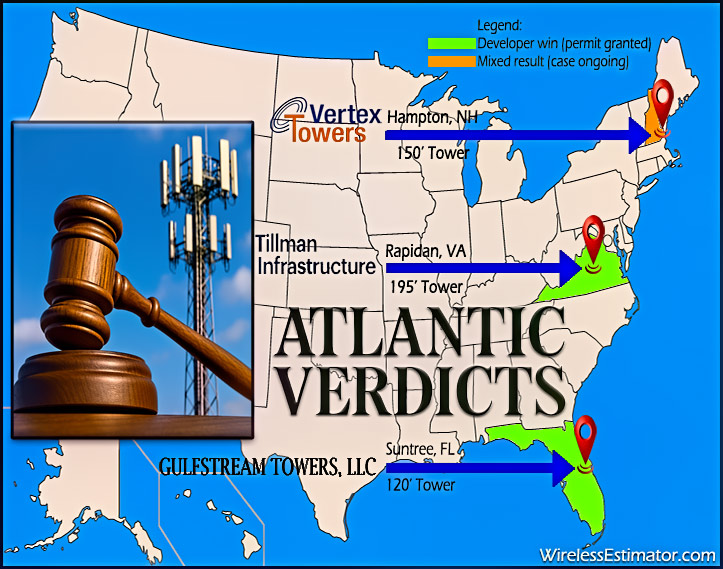
EAST COAST EDICTS — Federal appeals courts and a federal judge hand down rulings in three high-profile cell tower cases in New Hampshire, Virginia, and Florida.
Three separate rulings in New Hampshire, Virginia, and Florida over the past week have reshaped the legal landscape for wireless infrastructure deployment on the East Coast. From outright victories for developers to partial wins for a local government, the decisions highlight both the legal guardrails of the federal Telecommunications Act (TCA) and the consequences of procedural missteps by municipalities.
Rapidan, Virginia – Tillman Wins on Procedural Grounds
In Culpeper County, Virginia, Tillman Infrastructure sought approval to construct a 195-foot self-supported tower with an additional 4-foot lightning rod in the unincorporated community of Rapidan. The tower, designed to host up to four carriers, was pitched as necessary to address gaps in regional coverage.
The county board denied the application, citing a preference for co-location on existing towers, potential health and safety issues, and alleged negative visual impacts, including proximity to a scenic byway and historic battlefield. None of the claims, the court found, were backed by “substantial evidence” as required under the TCA.
However, the decisive factor was procedural. Under Virginia law, a locality must approve or deny a wireless application within 150 days. Culpeper missed that statutory shot clock, which the district court ruled meant the permit was “deemed approved” by operation of law. The Fourth Circuit upheld the ruling on procedural grounds, sidestepping the broader merits of the county’s justifications.
Suntree, Florida – Aesthetics Alone Don’t Cut It, Argued Gulfstream
In Florida’s Brevard County, Gulfstream Towers proposed a 120-foot monopole on the property of Hope Episcopal Church in the Suntree area to bolster T-Mobile’s network capacity.
The county rejected the application based solely on aesthetic objections from nearby residents—descriptions like “eyesore” and general opposition to the tower’s visibility dominated the record. The developer sued, arguing the denial violated the TCA’s requirement for substantial, objective evidence.
The U.S. District Court for the Middle District of Florida agreed, holding that generalized aesthetic complaints—even those from multiple residents—do not constitute the necessary evidentiary basis under federal law. The Eleventh Circuit affirmed, making clear that subjective objections without measurable, expert-backed impact findings will not withstand judicial scrutiny.
Hampton, New Hampshire – Local Government Holds Ground Against Vertex (For Now)
In Hampton, New Hampshire, Vertex Towers applied to build a 150-foot monopole (156 feet including lightning rod) at 17R Barbour Road, targeting a 1–2 mile wireless coverage gap. Local officials countered that a 110-foot tower would suffice, and raised concerns about visual impacts and potential declines in nearby property values.
The federal court sided with the zoning board, finding the denial supported by substantial evidence. Judge Paul Barbadoro noted the board did not improperly rely on health-based objections, which are preempted under the TCA.
Yet the ruling left a major issue unresolved—whether limiting the height effectively prohibits the provision of wireless service, a violation of federal law. That question remains for further litigation, meaning the case could still shift in Vertex’s favor if it can prove that the shorter tower cannot meet the service need.
Comparative Snapshot: The Three Rulings
| Case | Jurisdiction | Height Proposed | Location | Reason for Denial | Outcome |
| Tillman Infrastructure | 4th Cir. | 195 ft (+4 ft rod) | Rapidan, VA | No substantial evidence; procedural delay | Developer wins; permit deemed approved |
| Gulfstream Towers | 11th Cir. | 120 ft monopole | Brevard County, FL | Generalized aesthetic concerns | Denial overturned; developer wins |
| Vertex Towers | D.N.H. | 150 ft (156 ft total) | Hampton, NH | Height, visual impact, property value concerns | Town wins on most issues; effective-prohibition unresolved |
Federal Standards in Focus
The TCA prohibits local governments from unreasonably discriminating among providers of functionally equivalent services and from actions that “prohibit or have the effect of prohibiting” the provision of wireless services. Local denials must be backed by substantial evidence in a written record—meaning factual findings supported by objective data or expert testimony.
The Virginia and Florida rulings reinforce a key point:
- Procedural compliance is critical—miss a statutory deadline, and a permit may be deemed approved.
- Generalized aesthetic opposition, even if widespread, is rarely enough to justify a denial.
The New Hampshire case shows that when a board assembles a record with measurable visual and property-value evidence, a denial can withstand initial review. But even then, the “effective prohibition” test may still reopen the fight.
Why These Cases Matter
Wireless carriers and infrastructure developers are racing to meet expanding 5G and broadband demands, while localities seek to preserve community aesthetics and land-use authority. These cases illustrate the tightrope both sides walk:
- For developers: Missed municipal deadlines and vague objections are powerful tools in court.
- For municipalities: Detailed, expert-supported findings remain essential to defend denials.
- For residents: Public opposition must be tied to concrete, documented impacts to influence legal outcomes, not subjective aesthetic beliefs, home ownership devaluations, RF health concerns, and other reasons that are frequently ruled against by the courts.
With courts increasingly willing to enforce the TCA’s guardrails, more local zoning disputes may be decided not in council chambers but in federal courtrooms—where the gavel can quickly overrule local sentiment, such as in the case of Tillman and Gulfstream’s lawsuits.

















